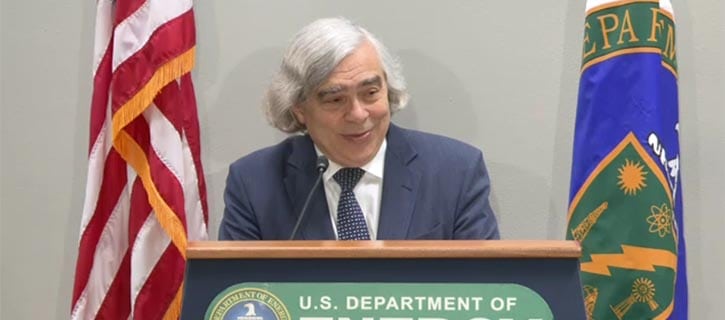Moniz: Incentives Needed to Alleviate Nuclear Power Woes
U.S. Secretary of Energy Ernest Moniz said the time will come—perhaps 10 to 15 years from now—when “nuclear power is going to have to see a substantial resurgence.”
Moniz was speaking on May 19 at the “Summit on Improving the Economics of America’s Nuclear Power Plants.” He provided opening remarks, framing the challenges facing the nuclear power industry, but not offering a remedy for the problems.
Economics Are Challenging Nuclear Power
“I think the challenge is very clear,” Moniz said. “With the economic challenges facing certainly some of our nuclear plants, we’re seeing—as you well know—some closures before license expirations. We’re seeing the prospect of even more. The importance of incentivizing continued operation, I think, is very clear, but the solutions are less clear.”
Moniz (Figure 1) noted that nuclear power accounts for roughly 60% of the U.S.’s zero-carbon generation. As such, he suggested that it is hugely important in the country’s quest to meet carbon reduction goals by 2030 and beyond.
“The idea is, we are supposed to be adding zero-carbon sources not subtracting or simply replacing by building to just kind of tread water,” Moniz said, referencing five plants that have already retired, three more that are scheduled to retire, the recent announcement that Fort Calhoun Station may shut down permanently, and news that another 6.5 GW of nuclear generation is at risk of closure by 2030.
Marvin Fertel, president and CEO of the Nuclear Energy Institute, agreed with Moniz, but believes the situation is even direr.
“We see 15 to 20 plants at risk of shutdown over the next five to 10 years,” Fertel said. “If we were to lose all those plants, and assuming they were replaced with the most high-efficiency combined cycle gas plants, it would wipe out approximately one-quarter of the gains achieved by the Clean Power Plan [CPP], if it was implemented.”
Zero-Carbon Generation Is Important
The fact is, a large dual-unit nuclear plant such as Exelon’s Quad Cities station, which happens to be one of the facilities at risk of closure, generates about as much electricity in an average year as was produced by all U.S. utility-scale solar facilities last year. Some experts think that losing such a plant could play havoc with state carbon reduction plans.
For example, as it stands now, Illinois must reduce its carbon emissions by about 30 million tons by 2030, if the CPP goes into effect. Losing the zero-carbon-emission generation from the Quad Cities and Clinton (a single-unit Exelon plant that is also on the chopping block) stations would mean the state would have to cut another 20 million tons from other sources in order to comply with CPP requirements. That’s a task that Rep. Adam Kinzinger (R-Ill.) suggested might not be possible.
“Shutting down nuclear power plants in Illinois puts us in a position where I don’t know if we could ever achieve what’s put out in front of us,” Kinzinger said.
Market Changes Needed
Many of the nuclear plants that have experienced economic troubles have been smaller single-unit facilities, but that is not the case with Quad Cities. Surprising as it may seem, Quad Cities is said to produce electricity for about $28/MWh—ranking it well within the top quartile of all U.S. nuclear plants—but it still can’t make ends meet under current market conditions.
“When this fleet of reactors was built, it was a very different market structure,” Moniz said. “It’s that change of market structure that has posed at least many of the challenges.”
Fertel also sees the competitive markets as the problem. He suggested that the markets haven’t yet developed the tools and techniques to value the different attributes of the various generation types. For example, some virtues of nuclear power that are not rewarded under the current market scheme include its dispatchability, reliability, availability, and zero-carbon emissions. The fact that many reactors refuel on 24-month schedules means that nuclear plants could continue operating, in many cases, if external events, such as a natural disaster, caused fuel delivery problems for coal- or gas-fired power plants, but that advantage, too, is not valued by the market.
“There is an enormous issue spanning the entire system in terms of addressing valuation,” Moniz said. “The alignment of benefits with costs, with market structure, is one that really requires … a much better characterization and pricing of benefits that we are seeing.”
Timing Is Critical
And time is not on the industry’s side, according to Moniz. The average age of U.S. commercial reactors is about 35 years. Even with license extensions, there will be a wave of retirements coming down the pike. Moniz suggested that the next 10 to 15 years must bridge to a time when nuclear power sees a substantial resurgence. Fertel (Figure 2) agreed that time is of the essence.
 |
2. Sense of urgency. Marvin Fertel provided an industry perspective during the “Summit on Improving the Economics of America’s Nuclear Power Plants” held on May 19. Source: U.S. Department of Energy |
“A sense of urgency and actions are really important,” Fertel said. “This is a serious [problem]. It’s a systemic problem. It’s not isolated. And it requires real action now, not five years from now, because we’ll lose a lot of plants over that five year period.”
—Aaron Larson, associate editor (@AaronL_Power, @POWERmagazine)
